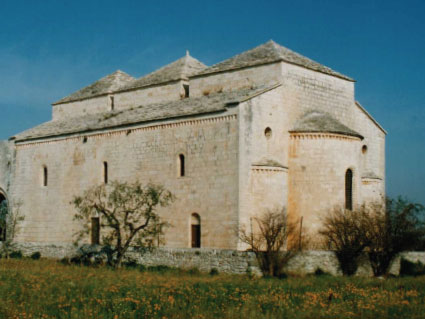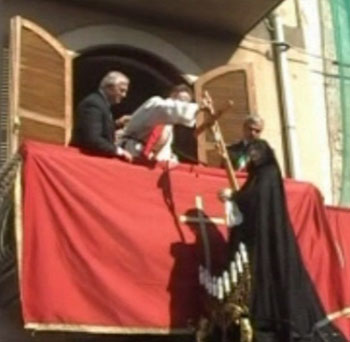





The common practice of following the Way of Sorrows by performing the rites of Holy Week has been a tradition of the Valenzano community for a long time. The oldest sacred image preserved by the town to this day is a valued mural painting of the Ecce Homo [Behold the Man] from the fifteenth century; a fine Crucifix from the same period is now preserved in the church of San Rocco. This Crucifix was originally articulated and the arms could move in order to show the un-nailing of Christ from the cross and the burial ritual. In 1675, records show that the guardian priest of the convent asked the Archbishop's Curia of Bari permission to make the Good Friday Procession, with some of the mysteries of the Passion and Angels. The document officially certifies the beginnings of the Good Friday procession in Valenzano, with the presence of children dressed up in costumes to represent the scenes of the passion through the streets while reciting the sad event. In 1696, the Franciscan Convent received a magnificent and precious Crucifix that was carved in wood by brother Angelo of Pietrafitta, to whose devotion a number of miraculous events are attributed. In 1706, in the same Franciscan church, a new wooden choir was built bearing four mural paintings representing the scenes of the Passion on its façade. In 1730, a stone monument of the Holy Cross was built in the convent’s churchyard. This Holy Cross bears five bas-relief scenes of the Passion: it is the point that indicates the beginning and the end of the people's Way of the Cross according to the teachings of the Franciscan Leonard of Port Maurice. In 1762, in the spandrels of the side altars in the nave of the church of S. Maria di S. Luca, a valuable tempera painting of the Way of the Cross was made on a thin layer of plaster. This is one of the most beautiful pieces of its kind preserved in Apulia. The involvement of the people was such that a number of families, initially relatives of the chapter members, began to participate in the rites with their own statues representing the Mysteries. The oldest recorded date refers back to 1746, and the dead Christ now preserved in the church of Santa Maria di San Luca, is probably from the same period. Initially the procession consisted of five or six Mysteries, similar in type and number to those present in many other towns in Apulia, their uniqueness lies in the fact that these Mysteries belong to private individuals. The mother church retains the excellently made representation of Our Lady of Sorrows, which was approved on April 27, 1888, by the Pious Union of Brothers and Sisters with the title Holy Mary Our Lady of Sorrows. From year to year, the number of Mysteries increased with a surge after the parochial missions of the Passion, first in 1928, and later, in 1951: the financial resources of certain families, aided by relatives working abroad, account for the the rest. Despite the socio-economic changes, the phenomenon has never ceased. Today, there are forty-seven Mysteries making Valenzano a stage for the Passion with few equals in Italy.

At the end of the procession of the Mysteries, the preacher, with a deeply dramatic homily, retells the story of the Passion through the piety of the common people represented by the 47 groups of statues At the end of the sermon the priest invokes the presence of the Madonna shouting "Mary here is your son". The statue, apart from the others, is brought quickly to the priest who places the Cross in the arms of Our Lady of Sorrows. The reunion of Mary and her son, shown in all her sorrow, completely draws the faithful in emotionally, reaching beyond the ritualism of the drama to a choral form of expression of intense participation.